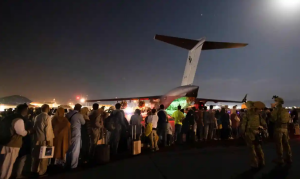Call for new emergency visa scheme
Australia should streamline its response to humanitarian crises around the globe by introducing a new dedicated ‘emergency visa’, a new report recommends.
Researchers Professor Jane McAdam and Doctor Regina Jefferies, of the Kaldor Centre’s Evacuations Research Hub, have called for the visa in a policy paper ‘Ensuring Protection in Humanitarian Emergencies: A framework for Australia’.
 They say that when crises threaten lives, the Australian government often steps up – but not always in a predictable, efficient, equitable and effective way, if responses to Afghanistan, Ukraine, Sudan and Gaza are anything to go by.
They say that when crises threaten lives, the Australian government often steps up – but not always in a predictable, efficient, equitable and effective way, if responses to Afghanistan, Ukraine, Sudan and Gaza are anything to go by.
For some people escaping these conflicts, travel to Australia has been relatively easy; for others, impossible.
Some people who reach Australia have rights to work, study, healthcare and support, while others are barely surviving.
Over time, Australia has issued at least 25 different visa types to assist people in humanitarian emergencies.
The researchers say that the Australian government should streamline its humanitarian crisis response with a new, dedicated emergency visa.
The policy paper proposes the new emergency visa as part of a holistic, more equitable and agile response to crises.
The visa would encompass both physical and legal protection, and the broader emergency response framework proposed could be activated when sudden or large-scale crises arise around the world; and tailored to the specific context.
It would be additional and complementary to Australia’s existing Refugee and Humanitarian Program, and it would provide an equitable and robust foundation to enable agile responses that could be quickly tailored to specific conditions.
The framework is designed with Australia in mind, but it could also be used as a model for other countries, the researchers say.
The policy brief sets out what an emergency visa should look like – including who should be eligible for the visa, what rights it would provide, and how long it should last.
It’s broader recommendations detail what the humanitarian emergency framework needs in order to achieve a more predictable, equitable, streamlined and efficient outcomes.
The paper recommends the framework “should be developed and implemented collaboratively with relevant stakeholders from all levels of government; relevant UN agencies (especially the UN High Commissioner for Refugees (UNHCR) and the International Organization for Migration (IOM)); refugee protection and settlement services; other relevant agencies and experts (including the Australian Refugee Advisory Panel); and representatives from affected communities”.
It “should be triggered as early as possible, and certainly once a humanitarian emergency has been declared”.
It says a disaster plan-like mechanism for the initial response within Australia would cut across bureaucratic red tape and swiftly mobilise resources.
And as part of the framework, the Australian government should ensure that people are granted an emergency visa to facilitate entry to, and protection in, Australia if a humanitarian emergency is declared.
“The visa should automatically permit an initial stay of at least 12 months (to provide immediate relief and time to assess conditions in the country of origin), with a pathway to permanent stay if it is not safe, possible or otherwise desirable for individuals to return home,” the paper says.
The paper says the framework should include plans for physical evacuation from affected countries, as well as from countries where people may have sought temporary safety.
“Each type of evacuation requires a different set of considerations, negotiations (with host governments, UNHCR etc) and contingencies. Immigration requirements should be kept to a bare minimum (eg identity and security checks) in order to facilitate swift movement out of dangerous and often traumatising situations,” it says.
Read the policy brief here: ‘Ensuring Protection in Humanitarian Emergencies: A framework for Australia’












